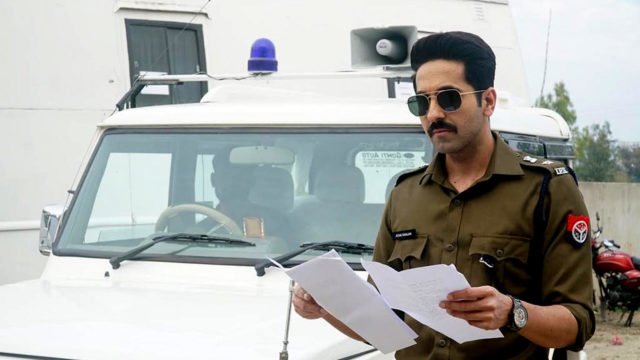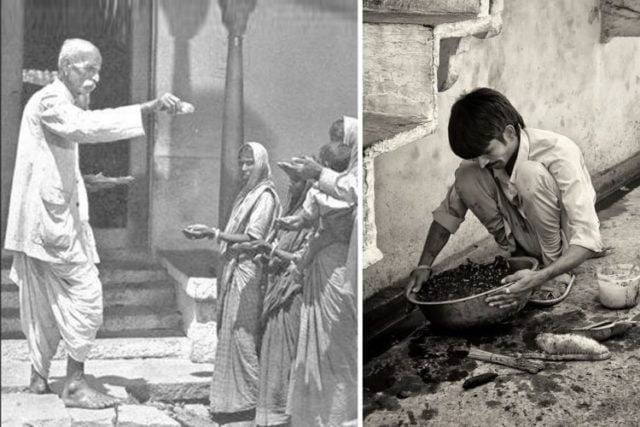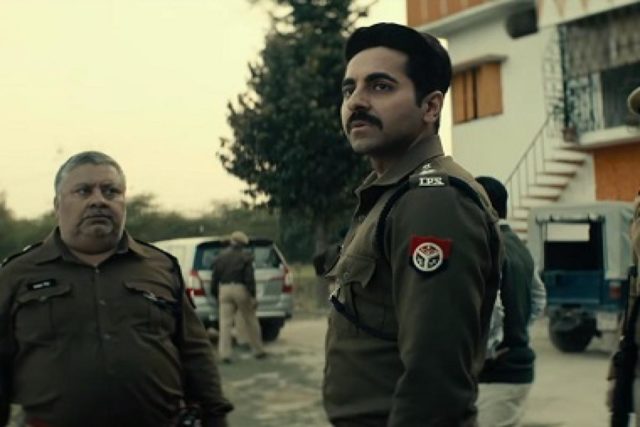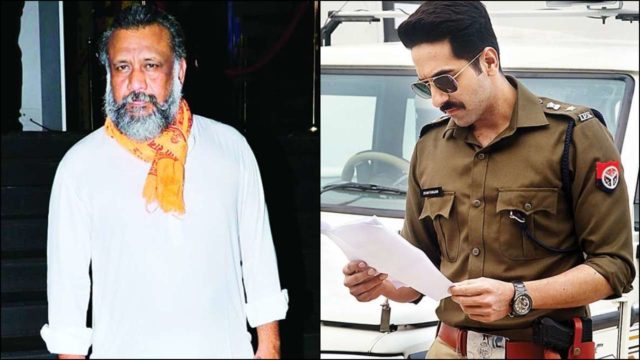By Bhavya Arora and Prannv Dhawan
If one wants to be moved and made uncomfortable by the changing spectrum and landscape of Bollywood movies, the prevalent harsh reality of oppressive social structures in the stratified and unequal Indian society, which is far away from our lives, yet co-exists and sustains itself in the remote recesses of our New India, then Article 15 serves exactly the purpose.

While the Union Budget of New India exposits the road-map for our national goal to become a $ 5 trillion economy, this movie uncovers the truth of Bharat where caste-based forced labor manifests into manual scavenging and the sacred dictum of purity and pollution manifests into brutal public flogging of Dalits.

In this context, this film takes the decisive leap of courage to state the reality of India’s social structures, and their institutional/political permeation in forms of police brutality and complicity in oppression.
In the era of majoritarian chest-thumping and tailor-made propaganda films made to promote an ideology, Article 15 comes as a strong attempt to provoke serious soul-searching on the oft-ignored caste question of the Indian republic.
It brings out the sheer hypocrisy of the upper class pantheon who extrapolate caste system as British colonial construct and also provide uncritical defence of the regressive social traditions like untouchability, prohibition of inter-caste marriages etc.
The internal and external cleavages within and amongst castes is also exposited with brutal and brilliant honesty. The spectacular similarity with contemporary political scenario and its critique is a bold divergence from the deferential, hero-worship culture in Bollywood.
This is especially true in the portrayal of Nishad as a character representing real-life, firebrand Bhim Army leader Chandrashekhar Azad who was incarcerated under the National Security Act in the recent past.
Its critique on electorally-motivated attempts of so-called caste unity by conservative, right-wing politicians like Mahantji is remarkable.
Also Read: The Most Controversial Laws In The Indian Constitution
In the ‘Policewala’ genre dominated by the likes of Ajay Devgn and Ranveer Singh, if anyone has done justice to it and rightfully so, it has to be Ayushman Khurrana.

He’s not playing the eternally confident, jumping over thellas in mandi, riding ‘on’ cars, macho dialogue speaking policeman, the image of which we’ve been fed all these years, rather he’s playing a cop as human as it gets, equally sensitive, vulnerable and confused.

Subject to the glaring realities of people who make our lives easier for two hours fifteen minutes, you start seeing the working and labour class (usually people from SCs, STs and OBCs) as equal humans and ask yourself, “This all can’t be a coincidence.”
It is when you see a pattern of castes and socio-financial conditions of people bearing them that you come to realize that there has been a history, a damaging one and only little has been done to correct it.
The sheer inhumanity of exclusion is presented be it at education, jobs, housing, or in context of the freedom to exercise religious beliefs or live without the threat of increasing hate crimes and targeted violence.
The marginalised section has been constantly denied any opportunity to advance, be at par with the privileged ones and break away from the menial chores that they were supposedly destined for.
It had to take an Anubhav Sinha and Ayushman Khurrana combination along with the path shattering support cast of Sayani Gupta, Isha Talwar, Ronjini Chakraborty Mohammed Zeeshan Ayyub, Manoj Pahwa, Kumud Mishra and Nassar to invest in a movie which tries its utter best to deliver the heinousness of a crime so widespread and far-reaching, yet invisible to naked eye.

Its portrayal of gruesome sexual violence as an extreme form of upper-caste hegemony and domination is incredibly impactful. The exposition of the series of events in the Badaun gangrape case powerfully question the ineffectual law and order mechanism and weak public conscience.

While one (like ACP Ayan Ranjan) is completely disgusted at the situation portrayed in the backward regions like Lalgaon, the covert complicity of urbane classes in similar acts of private discrimination and oppression like having separate utensils or lifts or forced domestic labor is also questioned.
The comfort of caste privilege and the consequent caste-blindness is realized when the film puts out the reality of opposition to social justice measures like reservation and discrimination against lower caste police personnel by upper castes in its trademark unabashed manner. Certain dialogues like, “Power ki alag hi jaat hoti hai (Power has a caste of its own)” stay back and ring in your ears every time you hear a saffron-clad neta give speech.
The film is optimistic in its own ways, though the characters are suffering and have their own fears and insecurities, they are no damsels in distress, they have already waged a war against the system.
There are posters of missing girl being pasted next to a wall painting which calls for empowerment of young girls through education, ‘bidaai’ song is being played while the father of deceased girls is performing their last rites.
The film is trying to touch upon all the gruesome facets of their life through excellent contextual cinematography and plot-setting, be it manual scavenging, the relegation of ‘dirty’ animal skinning work, brutal beatings for the ‘crime’ of temple entry, ill equipped huts or the mere sight of Pooja lying unconscious in the jungle for days altogether, while you lay back thinking, “Nobody deserves this!”
One realises the world of difference between their everyday struggles and yours. Jatav’s question resonates for once and all,
“Aakhir kab tak jhaadu maarenge?”
“(Till when do you expect us to engage in filthy and menial jobs)”
Ultimately, the film celebrates the real spirit of Indian nationalism that is essentially aspiring for social transformation of our grim realities by using the Constitutional principles of equality and provisions like Article 15 as a potent tool.
Image Source: Google Images
Sources: Marked inside
You’d Also Like To Read:






























This was a brilliant movie. And Ayushman Khurrana was brilliant in it. However this and many other articles disrespect an actor like Ajay Devgn when comparing performances. People are quick to forget that Ajay Devgn starred in one of the greatest and well made cop dramas ever made – Gangaajal – where his performance was nominated for a national award. Along with that he has also starred in many movies like Aakrosh. But people just tend to remember him in movies like Singham and disrespect his acting ability.